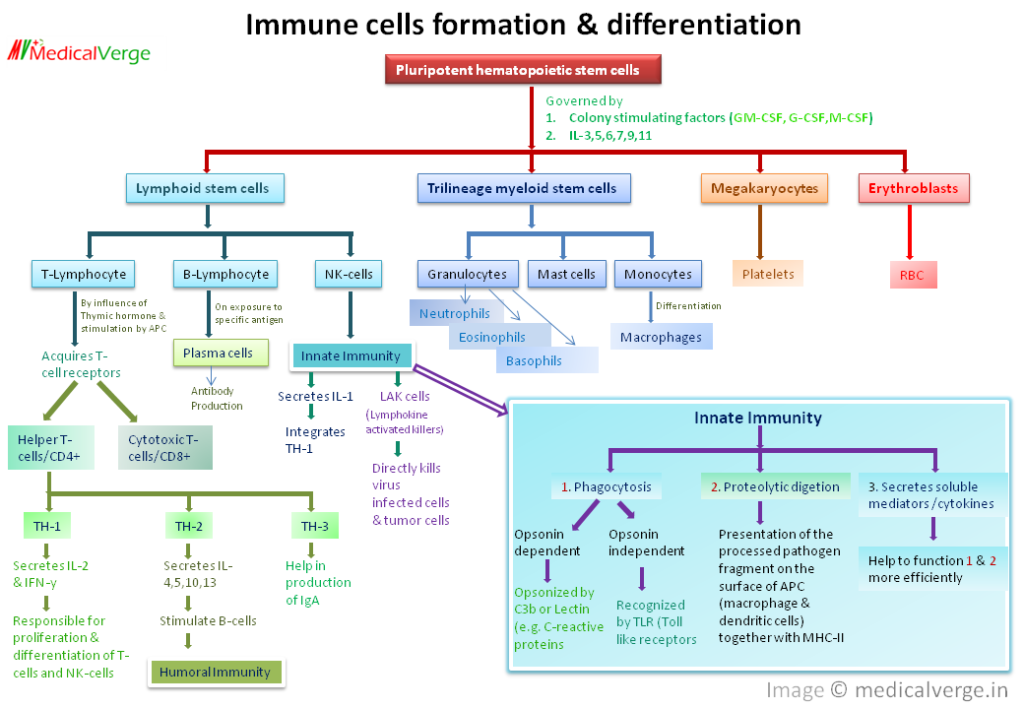Humans are exposed to a variety of pathogens every day, but they do not cause infection or illness each time. This is possible because the body has its defense system to combat with these pathogens, called the immune system. There are two kinds of immune mechanism, innate immunity and adaptive (acquired) immunity.
Innate immunity is the body’s first line of defense, designed to destroy or limit the growth of invading organisms immediately. It is non-specific, i.e. Works on all pathogens in the same way. Adaptive immunity, on the other hand, involves immune cells going through a sequence of positive and negative selection processes to achieve specificity or selectivity against a pathogen. It is a slow process that develops memory cells to remember the way of killing or pathogen’s structure to kill it quickly on re-exposure.
Since the innate immune response mechanism is non-specific to pathogens and is designed to combat them rapidly, a cytokine storm or inflammatory response can develop, manifesting clinically as fever or local complications such as respiratory symptoms. Concurrently, it also stimulates adaptive immune response by recruiting antigen presenting cells to handle the pathogen in the best way. The flowchart diagram-1 below depicts the development, differentiation, and function of immune system cells.

Features of Innate immune response
- Immediate onset of action
- Antigen recognition is restricted to limited sets of receptors that can only recognize common molecules on the surface of microbes.
- Involvement of only macrophages, dendritic cells, neutrophils, basophils, eosinophils, mast cells, alternate pathway of complement system, interferon and natural killer cells (NK-cells).
Components of Innate Immune response
Complement system – There are 11 complement protein marked from C1 to C9 with 3 subgroups of C1. It reacts in a fixed sequence (cascade) on stimulation. Figure-2

Neutrophils – It engulfs invading pathogens by endocytosis (destroy within the vesicle by myeloperoxidase enzyme) or by secreting defensin.
Eosinophils – Defense against parasites (which is too large to be engulfed). It attaches and secretes cytotoxic substances onto the parasite surface.
Basophils & Mast cells – IgE antibodies bind to Mast cells or basophils, causing degranulation which release histamine and leukotrines.
Monocytes/Macrophages – It differentiates into macrophages and serves as an antigen-presenting cell (APC) for T-cells, allowing them to initiate adaptive immune responses. Macrophages destroy pathogens by phagocytosis of opsonized pathogens.
Dendritic cells – they reside in non-lymphoid tissue as inactive and immature. It migrates to lymphoid organs (lymph nodes and spleen) after activation, where it matures. Via MHC class 2 proteins, they serve as an APC to T-cells. T-cells are then processed further by adaptive immune responses.
Natural Killer cells – NK-cells destroy tumor cells and viral infected cells directly. They recognize the cells that had down-regulated MHC class 1 protein on the cell surface. This function of NK-cell is known as “kiss of death.” It secretes perforins and granzymes, which lead to cytolysis of microbes and tumor cells.